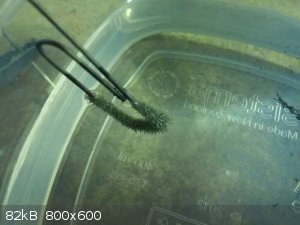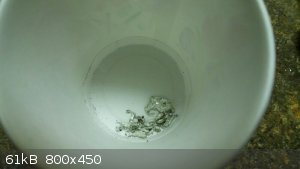DFliyerz
Hazard to Others
  
Posts: 241
Registered: 22-12-2014
Member Is Offline
Mood: No Mood
|
|
Tin, Lead, and Silver from Solder
For once, I've actually completed a procedure before posting it here, so here we go:
Starting with 15 grams of solder recovered from desoldering various boards, I dissolved the solder in nitric acid and was left with a precipitate of
hydrated tin oxide which could then be dried and reduced to tin metal (I didn't do this and threw the oxide away for some reason!) Next, the solution
is neutralized with sodium hydroxide before filtering it again and using a copper wire to precipitate the silver. After filtering off the silver I
ended up leaving the silver on the filter paper and using a micro butane torch to both burn the paper and melt the silver, which was surprisingly
effective and I ended up with a few miniscule balls of silver metal. Finally, sodium chloride solution was added to the remaining solution,
precipitating lead chloride which was filtered off. To do next is to recover and reduce the tin oxide with carbon, and to treat the lead chloride with
sodium hypochlorite to precipitate lead dioxide which can then be heated to form lead oxide and then reduced. But, there you have it; three somewhat
hard to come by metallic elements from waste solder.
[Edited on 9-15-2015 by DFliyerz]
|
|
|
unionised
International Hazard
    
Posts: 5102
Registered: 1-11-2003
Location: UK
Member Is Offline
Mood: No Mood
|
|
I'm fairly sure that you can reduce the lead chloride directly with carbon in the presence of an alkaline flux like sodium carbonate.
|
|
|
DFliyerz
Hazard to Others
  
Posts: 241
Registered: 22-12-2014
Member Is Offline
Mood: No Mood
|
|
Quote: Originally posted by unionised  | | I'm fairly sure that you can reduce the lead chloride directly with carbon in the presence of an alkaline flux like sodium carbonate.
|
If you have any idea on the stoichiometry, I'd love to give this a try!
|
|
|
battoussai114
Hazard to Others
  
Posts: 235
Registered: 18-2-2015
Member Is Offline
Mood: Not bad.... Not bad.
|
|
Seems pretty cool! If I weren't lead-phobic I'd certainly give it try....
To illustrate how-much-phobic I've got a PCB waiting for a reflow work for months now and I don't want to use my oven for it.
Batoussai.
|
|
|
aga
Forum Drunkard
    
Posts: 7030
Registered: 25-3-2014
Member Is Offline
|
|
What Silver ?
Solder was 60/40 Tin/Lead apart from Special Applications (like soldering to Al).
All changed in 2006.
What 'solder' are you using ?
|
|
|
battoussai114
Hazard to Others
  
Posts: 235
Registered: 18-2-2015
Member Is Offline
Mood: Not bad.... Not bad.
|
|
Quote: Originally posted by aga  | What Silver ?
Solder was 60/40 Tin/Lead apart from Special Applications (like soldering to Al).
All changed in 2006.
What 'solder' are you using ? |
This is for solder sold to the public. Composition may/will varie a lot for industrial applications. For instance high temperature solder contains
silver, while solder for BGA and reflow is sometimes made of tin/silver/copper.
Batoussai.
|
|
|
Bert
Super Administrator
        
Posts: 2821
Registered: 12-3-2004
Member Is Offline
Mood: " I think we are all going to die. I think that love is an illusion. We are flawed, my darling".
|
|
There are a HUGE range of materials sold as "solder". Eutectic Pb:Sn is 60:40 (actual eutectic is 63:37, but close enough...)
Pity you discarded the Tin, if you had weighed it at least we could know the proportions of your alloy.
From the ever unreliable Wikipedia:
| Quote: |
Sn-Ag-Cu (Tin-Silver-Copper) solders are used by two thirds of Japanese manufacturers for reflow and wave soldering, and by about 75% of companies for
hand soldering. The widespread use of this popular lead-free solder alloy family is based on the reduced melting point of the Sn-Ag-Cu ternary
eutectic behavior (217 ˚C), which is below the Sn-3.5Ag (wt.%) eutectic of 221 °C and the Sn-0.7Cu eutectic of 227 °C
|
Rapopart’s Rules for critical commentary:
1. Attempt to re-express your target’s position so clearly, vividly and fairly that your target says: “Thanks, I wish I’d thought of putting it
that way.”
2. List any points of agreement (especially if they are not matters of general or widespread agreement).
3. Mention anything you have learned from your target.
4. Only then are you permitted to say so much as a word of rebuttal or criticism.
Anatol Rapoport was a Russian-born American mathematical psychologist (1911-2007).
|
|
|
kadriver
Hazard to Others
  
Posts: 196
Registered: 7-11-2012
Location: United States
Member Is Offline
Mood: Thankful
|
|
Quote: Originally posted by DFliyerz  | For once, I've actually completed a procedure before posting it here, so here we go:
Starting with 15 grams of solder recovered from desoldering various boards, I dissolved the solder in nitric acid and was left with a precipitate of
hydrated tin oxide
[Edited on 9-15-2015 by DFliyerz] |
In my refining experience, I was taught that tin dissolved in nitric acid produced a thick paste called metastannic acid that made filtering
impossible. To turn it into tin oxide the metastannic acid must be incinerated - heated to redness - the resulting tin compound is not very soluble in
acids and it can then be filtered out without gumming up the filter paper.
I think the lead and silver both go into solution. How were you able to separate the tin paste from the two other dissolved metals? Just curious and
always looking to learn something new to help me in the future.
kadriver
|
|
|
DFliyerz
Hazard to Others
  
Posts: 241
Registered: 22-12-2014
Member Is Offline
Mood: No Mood
|
|
Quote: Originally posted by Bert  | There are a HUGE range of materials sold as "solder". Eutectic Pb:Sn is 60:40 (actual eutectic is 63:37, but close enough...)
Pity you discarded the Tin, if you had weighed it at least we could know the proportions of your alloy.
From the ever unreliable Wikipedia:
| Quote: |
Sn-Ag-Cu (Tin-Silver-Copper) solders are used by two thirds of Japanese manufacturers for reflow and wave soldering, and by about 75% of companies for
hand soldering. The widespread use of this popular lead-free solder alloy family is based on the reduced melting point of the Sn-Ag-Cu ternary
eutectic behavior (217 ˚C), which is below the Sn-3.5Ag (wt.%) eutectic of 221 °C and the Sn-0.7Cu eutectic of 227 °C
|
|
It was from probably tens of different boards from all different years, so it'd be pretty variable.
|
|
|
DFliyerz
Hazard to Others
  
Posts: 241
Registered: 22-12-2014
Member Is Offline
Mood: No Mood
|
|
Quote: Originally posted by kadriver  | Quote: Originally posted by DFliyerz  | For once, I've actually completed a procedure before posting it here, so here we go:
Starting with 15 grams of solder recovered from desoldering various boards, I dissolved the solder in nitric acid and was left with a precipitate of
hydrated tin oxide
[Edited on 9-15-2015 by DFliyerz] |
In my refining experience, I was taught that tin dissolved in nitric acid produced a thick paste called metastannic acid that made filtering
impossible. To turn it into tin oxide the metastannic acid must be incinerated - heated to redness - the resulting tin compound is not very soluble in
acids and it can then be filtered out without gumming up the filter paper.
I think the lead and silver both go into solution. How were you able to separate the tin paste from the two other dissolved metals? Just curious and
always looking to learn something new to help me in the future.
kadriver
|
I just filtered it without any problems, but this time I'm going to modify my procedure and treat the solder with hydrochloric acid first to get
tin(II) chloride instead of tin(IV) oxide, which I can then electroplate into nice crystals and avoid carbon reduction entirely.
|
|
|
soniccd123
Harmless

Posts: 10
Registered: 20-1-2014
Location: Brazil
Member Is Offline
Mood: No Mood
|
|
It is perfectly possible with hot 30% hydrochloric acid, but beware that some of the Lead will dissolve (from my own experience), My resulting
solution gave me the classical gold precipitate with Potassium Iodide.
To prepare the solder for the reaction, i melted it (round 20g) and poured it hot in a ceramic tile, so it splashed and formed a very thin spill of
solid metal. I cut the spill with scissors in small pieces and used these pieces in the reaction.
I did made only rough measurements before and after the reaction (my precise scale had just stopped working), but from the rough results, it seems to
have dissolved Tin and left behind most of the Lead.
|
|
|
unionised
International Hazard
    
Posts: 5102
Registered: 1-11-2003
Location: UK
Member Is Offline
Mood: No Mood
|
|
I'd not bother worrying- use lots of the two cheap things.
|
|
|
Bert
Super Administrator
        
Posts: 2821
Registered: 12-3-2004
Member Is Offline
Mood: " I think we are all going to die. I think that love is an illusion. We are flawed, my darling".
|
|
Hasn't anyone else read Georgius Agricola' de re Metallica?
Lots of stuff on Lead, Copper, Silver (and Gold) separation...
Get pragmatic, appropriate physical means of separation to complement the chemical ones.
http://www.gutenberg.org/files/38015/38015-h/38015-h.htm
[Edited on 17-9-2015 by Bert]
Rapopart’s Rules for critical commentary:
1. Attempt to re-express your target’s position so clearly, vividly and fairly that your target says: “Thanks, I wish I’d thought of putting it
that way.”
2. List any points of agreement (especially if they are not matters of general or widespread agreement).
3. Mention anything you have learned from your target.
4. Only then are you permitted to say so much as a word of rebuttal or criticism.
Anatol Rapoport was a Russian-born American mathematical psychologist (1911-2007).
|
|
|
DFliyerz
Hazard to Others
  
Posts: 241
Registered: 22-12-2014
Member Is Offline
Mood: No Mood
|
|
Two more pictures for you guys, this time of a completed tin recovery process:
1. Electroplating tin metal from stannous chloride solution.
2. Nice and shiny tin metal after melting down the crystalline tin.
 
|
|
|
BlackDragon2712
Hazard to Others
  
Posts: 124
Registered: 22-12-2012
Location: Everywhere
Member Is Offline
Mood: Sleepy
|
|
If you are interested just in the tin (like myself) would it be better to put the crushed alloy in a concentrated, stoichiometric solution of copper
sulphate? It would form tin (II) sulphate which is fairly soluble in water, lead would remain as the metal since the solubility of the sulphate in
water is very low. The lead then can be brought into ionic form with nitric acid or another acid, the tin (II) sulphate can be reacted with calcium or
barium chloride, precipitating calcium (II) sulphate and leaving tin (II) chloride in solution.
Of course this is just an idea but it seems like a very nice, clean and simple method rather than dealing with strong acids and toxic lead ions in
solution, what do you think?
|
|
|
aga
Forum Drunkard
    
Posts: 7030
Registered: 25-3-2014
Member Is Offline
|
|
Funny.
I wanted some tin yesterday to make Stannous Chloride for Gold detection (cheers kadriver) so attempted tin extraction from some 'lead-free' plumbers'
solder.
It simply got thrown in a beaker with some 20% HCl and shiny metal flakes appeared after heating.
In a test tube a small sample was tested with nitric acid and it went Green ?!?!
Not Silver then.
Assuming the same about Solder as Bert just said i just bought some powdered Tin instead.
[Edited on 21-9-2015 by aga]
|
|
|